|
|
|
|
|
|
 |
|
|
| A study of MADAGASCAR CORUNDUM |
|
|
|
| AL2O3 |
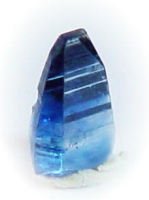
Sapphire found in a metamorphic marble.
|
| · Crystallographic properties of corundum: |
| Trigonal.c = 1,3630 pp 0 86°4' ; pa1 = 122°26' |
| Macle according to p (1011), often polysynthetic, |
| accompanied by plans of separation, similar plans are also |
| observed according to a1 (0001) unequal break to conchoïdal. |
|
| Hardness 9. Density 3,95 to 4,1 Refractive index: 1.76 - 1.77 |
| Uniaxial and optically négative.ng = 1,7675; Np = 1,7593 |
| The faces a1 frequently show the phenomenon of asterism, |
| generally due to reflexions within separation p. |
| Strong polychromatism , with following maximum ng. |
| · Chemical properties: corundum is composed of pure |
| alumina; its colouring is due to metallic oxide traces or inclusions. |
 The story The story |
| The color of sapphire, due to iron and titanium oxide, gives its |
| best effect under daylight. Electric light makes it often dark. |
| The color of the ruby, due to chromium oxide, on the contrary shows |
| its most luminous red under electric lighting. |
|
|
|
| |
| In Madagascar, corundum shows two different aspects: |
 |
| 1 stony and opaque crystals. |
| 2 crystals of smaller size often transparent and usable as gem. |
| In Madagascar, stony corundum comes from mica schists metamorphosed by granite, as well as |
| endomorphosed granitic veinules and more or less deprived of quartz which injects those. Silimanite is |
| an usual satellite of corundum in this type of deposit. One also finds some one in eruptive rocks, |
| syenites. |
| Gems are generally found in alluvium, but occur either from basaltic slags, or from metamorphic |
| marble or endomorpheous feldspatic rocks. |
|
|
|
|
|
 1 1 |
 2 2 |
 3 3 |
 4 4 |
 5 5 |
| One distinguishes two principal types of corundum in Madagascar: |
| Type I : isoceloedric, more or less acute accompanied or not by a small face a1 (0001) and more rarely |
| by facets p (1011). Represented by figures 1 to 11, but which often become complicated in |
| consequence of the irregularity of the development of some of their faces and by stacking with |
| parallel axes of a great number of individuals. |
| |
|
|
|
|
|
|
 6 6 |
 7 7 |
 8 8 |
 9 9 |
 10 10 |
|
|
|
|
|
|
|
|
|
|
|
| |
 11 11 |
 12 12 |
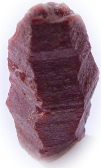 |
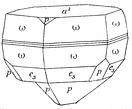 13 13
|
| Scalenoedron |
Stacking with parallel axes, |
Crystal supporting on one of its bases |
|
gutters at contours of the face. |
a small rhombohedron p in parallel |
|
|
|
position. |
|
|
|
|
|
|
|
|
|
|
| Type 2: Characterized by the association of the prism d 1 (1120) at a broad base, with which can |
| associate the isosceles ones, among which e 3 is most frequent, as well as the rhombohedron p. |
| The base of Malagasy corundum crystals very frequently shows scratches or triangular figures in |
| relief, limited by p. |
|
|
|
|
|
|
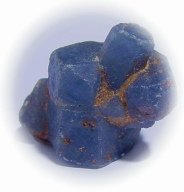 |
|
|
|
|
|
 |
| Macle of blue corundum. |
|
 |
|
|
 |
|
|
|
| Translucent violet - pink sapphire |
 |
|
|
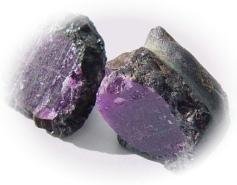 |
|
|
|
 |
|
|
| Ruby in amphibolite. |
|
|
|
|
|
|
|
|
|
| The crystals engaged in rocks, rich in mica, have rough faces encrusted of biotite or muscovite, minerals |
| which also exist at the state of inclusions, associated with magnetite and pyrite. |
| Because of its hardness, its inalterability and its density, corundum constitutes a standard mineral of |
| alluvia. |
|
|
|
|
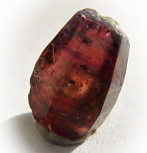 |
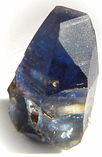 |
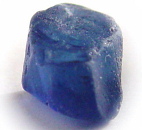 |
| Polychrome Sapphire |
Blue Sapphire ( origin: |
Blue Sapphire ( origin: Ilakaka 1999 ) |
| ( origin: Iankaroka 1990 ) |
Andranondambo 1992 ) |
Found in the sandstones of Isalo in |
| This sapphire comes from a granit, |
The stone comes from |
alluvium, the shape is rounded. |
| its shape is intact. |
a metamorphic marble. |
The origin of the stone is a marble. |
|
|
| · The structure of crystals. |
| It is R.J.Haüy who put forth the first assumption, confirmed 200 years later, on the structure of the |
| crystallized material. He lets drop accidentally a calcite crystal which broke into small rhomboedrons. He |
| supposed whereas the crystals were consisted of stacking small rhomboedrons elementary (that he called |
| the "integral molecule"), he could reconstitute all known shapes of calcite. In a crystal lattice, three atoms |
| or groups of atoms (nodes), which is not on the same line, determine a plan called reticular plan. But there |
| is a great number of these plans: it is enough to choose nodes not strictly nearby. As the network is infinite, |
| there is even an infinity of possible plans. The dimension of the faces does not play any role. During its |
| growth, a face can develop more quickly than another. The angle that the faces make between them |
|
remains constant, since it depends on the network. This structure of the crystalline material explains the
|
| law of the constancy of the dihedral angles. |
|
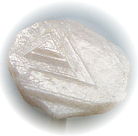 |
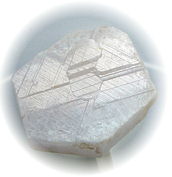 |
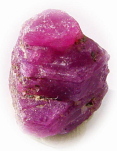 |
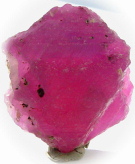 |
| Triangular figure on a |
Scratches on a rare |
Stacking in macle |
Triangles on a translucent |
| colorless corundum. |
colorless corundum. |
of a ruby. |
corundum. |
| |
 |
|
| The alluvial ruby deposit of Ambatovaravarana in the highlands, |
| is located in the center on the picture, under the hill. © Image J. Darbellay |
| |
 |
|
Your guide to GGGems |
 |
©  All of the pictures on this website have been shot by gggems.com All of the pictures on this website have been shot by gggems.com |
Alain Darbellay |
| Text written by Alain Darbellay. |
|
|